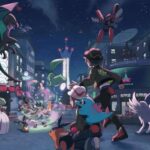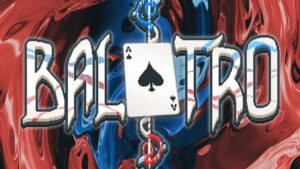Deus Ex is celebrating its 25-year anniversary today, June 23, 2025. Below, we chat with designer Steve Powers about how he created one of the most franchise’s most iconic stages.
Steve Powers has never visited Hong Kong, but he’s been there in his dreams.
As a designer on the original Deus Ex, he walked the city’s in-game streets every day for more than two years. Development was, he says, “a bit of a haze” of hard work and at least once, when he closed his eyes at night, he saw those virtual canals and neon-lit alleys: those sides of meat hanging in the market and the fog draping a temple in the city center.
Powers, the lead designer of the Hong Kong level, says he wanted to give players a “John Woo fever dream”–and 25 years after the immersive-sim classic was released, the space he created feels as evocative, generous, and extravagant as it did then, from its underground nightclub flashing with strobe lights to the precarious balconies a dozen floors up, coaxing the player to leap into the grey night.
Hong Kong is just one of 13 levels in Deus Ex, but it feels like a game hub in itself. It is a warren; its connected spaces feel, at once, utterly unique and yet still from the same world, or at least the same mind. From speaking to Powers on a video call from his home in Texas, it’s clear that Hong Kong’s undeniable flow comes from his singular, personal, and admittedly inauthentic vision of what that city should feel like–and from a clear desire to reward players’ curiosity.
He was one of four designers who each owned a chunk of Deus Ex, and these pieces had prescribed inputs and outputs. For Hong Kong, the player–JC Denton–is arriving to learn more about shadowy antagonists Majestic 12 and the mysterious Maggie Chow, as well as to find the scientist Tracer Tong so they can neutralize their self-destruct “kill switch”. The player must leave Hong Kong having learned the truth about the links between Majestic 12 and a worldwide plague, and having acquired a powerful weapon for the game’s second half: the iconic, glowing Dragon’s Tooth Sword.
Within those parameters, Powers had near-total creative freedom. Developer Ion Storm couldn’t pay for a Hong Kong trip, so he drew on his love of the action director John Woo, and turned to the monumental book collection of the game’s director, Warren Spector. “He had a giant shelf full of picture books from Hong Kong, so I’d literally flip through those and put post-its on pages,” he says. “That’s where it came from: John Woo, Hollywood, and stacks and stacks of books.”
The image in his head was of a busy, smoky street at night, lit only by vertical neon signs–that became Tonnochi Road, named after the real-life Tonnochy Road in Hong Kong’s Wan Chai district. He bolted bits on, “like building with LEGO,” and this unguided, free-flowing approach led to “happy coincidences.”
For example, he created a tall building and hollowed out a cosy apartment, designed so that players could learn more about their brother, Paul Denton. Powers went into the engine and peered out the window, as a player would.
“And there’s this tall building [opposite], and I think, it’d be cool if I could see something up there. And then the pieces just start coming out of that–oh, that’s where Maggie Chow [should] live. If I was Paul Denton, I could be spying on her from here.” Immediately, he hopped over the road and built Chow’s apartment, where the player will later find the Dragon’s Tooth Sword.
“The way I like to work is just to get in a level that’s blocked out, and put on my ‘player glasses,'” Powers says. “I’m not going to think about level design, or the academic principles of making a game, I just go, ‘What do I want to do right now?’
“I love getting to a place and looking down and you get a little tingle in your tummy because it’s so high up … And I want to run, and leap over a chasm, and land on a balcony on the other side. That sounds cool. And then I figure out why it’s there after the fact.” In the finished game, players can indeed leap from Maggie Chow’s building to that first apartment Powers built.
His building upwards and outwards was by no means random, he says, and was guided both by the plot–players must visit a market, a club, a triad base, and a hidden laboratory belonging to the VersaLife corporation–and by a desire for changes of rhythm. But the result feels serendipitous. You know when you turn a corner that the music, the color palette, and the vibe will shift, and you’ll find something worth investigating.
In replaying the game, I visit Hong Kong’s canals and get lost on its walkways, passing barges and rowing boats. I take a narrow alley, emerging into a frosty room with meat hanging on hooks and a figure lurking in the shadows. Powers made that space, a freezer room for the Old China Hand waterside bar, specifically to break up the warm neon colors of Hong Kong with cool blues, he says.
His desire for a huge, varied world made adapting to player choice, a hallmark of Deus Ex, more complicated. Players are supposed to meet Maggie Chow before finding the Dragon Tooth’s Sword, which will, in turn, prove her part in a major conspiracy. But her apartment has multiple entrances, including through a skylight, and you can break in to find the sword without talking to her. If that happens, she’ll confront the player much later on, berating them for their “terrible manners”.
“For every single opportunity I would give the player to do things out of order, it exponentially complicated some logic,” says Powers. “What is Maggie Chow going to say to you if you already have the sword the first time you meet her?”
That, to many players, and to Powers, is the joy of Deus Ex. “What are all the things the player could’ve done before getting here, and let’s have the game respond, make sure that’s accounted for. It makes the game feel alive and real.”
You can break the fiction, “but it holds together just enough where sympathetic players create their own logical leaps,” Powers says. “If the player has enough reason to believe that everything is accounted for, then when they’re presented with something that doesn’t work out that way, they’ll solve it themselves–they’ll help us out a little bit.”
It’s easy to become one of those sympathetic players in Hong Kong. You not only forgive leaps of logic, but you begin telling stories in your head to fill in the graphical gaps and the empty streets–about why that canal boat is parked right next to that freezer room, for example. “The fidelity is really lacking in Hong Kong,” Powers says, “but the idea is, let’s show how this world actually works. A barge comes in from the bay and down the canal and comes here, and offloads all these frozen goods, and this is where they store them for the kitchen. I wanted it to make sense as a liveable space.”
Not every part of Hong Kong has aged well.

Even at the time, the local accents sounded like exaggerated stereotypes. Powers recalls criticism after the game was released. But many of the characters, he says, were voiced by local people–they just weren’t professionals. “I remember getting dinged, ‘The accents are so weird and fake,’ and I was like, that was real people from Hong Kong reading those lines. They were just bad actors so it came across as stilted and weird.”
Some of the characters, however, were voiced by Western actors, including both Maggie Chow and Tracer Tong. Powers says he wasn’t involved in the casting and recording, but knows that, for most of the team, it was the first fully voiced game many of them had worked on.
“I’m certain that a number of things would be done differently today,” he says. “On Prey and Redfall we cast actors that suited the ethnic and cultural backgrounds of the characters, and when we had writers generating dialog for a culture that wasn’t their own, we hired the appropriate consultants to review and comment on the content so that we could adjust. I’m sure if we were making Deus Ex today, we’d have similar values.”
This is not an authentic version of Hong Kong. “Anyone going to Hong Kong is not going to see any of this,” he says. He’s “sure it was on his mind” that he was portraying a different culture and that people from Hong Kong might play the game, but “there’s never any intent to do anything other than to do a respectful presentation [of local culture]. That was the hope.”
This is Steve Powers’ version of Hong Kong, his own “John Woo fever dream”, his vision of a city.
As if to illustrate the point, Powers even modelled one of his body parts into the game, after programmers on the team showed him how to make complex shapes, he says.
It sits on a plinth in the lobby to the VersaLife headquarters, reflecting off the red marble floor, and slides back to reveal an underground laboratory where the Gray Death, the plague threatening the world, is being manufactured.
It is a giant hand, reaching towards the player, grasping at a globe, a metaphor for power.
On our call, Powers stretches his fingers towards his webcam.
“That’s this hand.”









